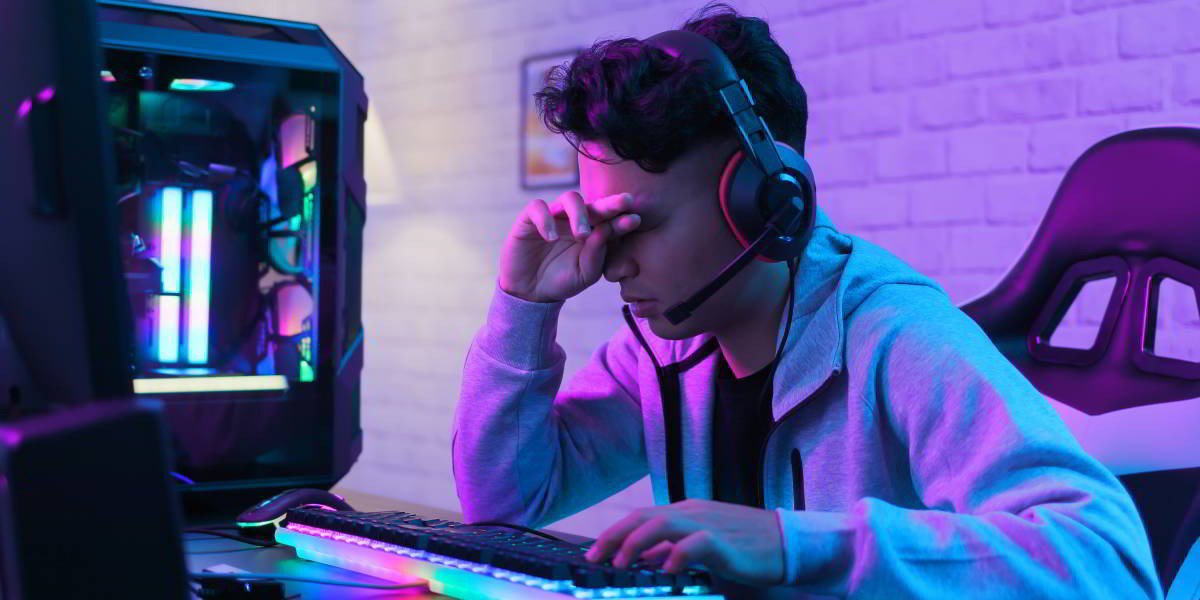Eye strain from prolonged computer use is a common issue, impacting comfort, productivity, and even sleep. Luckily, several effective strategies can help prevent and alleviate it:
Monitor Setup
Distance and Position
Maintain an arm’s length distance between your eyes and the screen. Position the monitor slightly below eye level, with the top third at your gaze. Sitting too close to the screen or having it positioned too high or low forces your eyes into uncomfortable angles, contributing to fatigue and strain over time.
Brightness and Contrast
Adjust brightness and contrast to a comfortable level, avoiding excessive glare. A good rule of thumb is to set the brightness slightly dimmer than your surrounding environment. High contrast between bright white backgrounds and dark text can also cause eye strain. Look for monitors with flicker-free backlighting for additional comfort.
Night Light Mode
Use built-in night light features or apps like f.lux to reduce blue light emission from your screen, especially in the evening. Blue light exposure in the late evening can disrupt sleep cycles and harm circadian rhythms. Warmer light hues are gentler on your eyes.
Font Size and Glare Reduction
Increase font size for better readability, as small text forces eyes to work harder. Verify that screen fonts and sizes are optimized for your operating system and apps. Also consider anti-glare filters if screen reflections from ambient lighting cause discomfort. Filters help diffuse glare.

Eye Exercises and Breaks
20-20-20 Rule
Look away from the screen every 20 minutes and focus on something at least 20 feet away for 20 seconds. This simple exercise allows your eyes to relax, adjust, and refocus, reducing accumulated strain. Set a reminder if needed.
Blinking
Staring at a screen reduces natural blink rate, causing eye dryness and discomfort over time. Consciously blink more often to keep your eyes lubricated and prevent dryness. Complete awareness and lubrication provides relief.
Eye Stretches
Perform gentle eye stretches like rolling your eyes in circles, shifting focus between near and far objects, palming (cup your hands gently over eyes without applying pressure), and massaging your temples to improve blood flow and reduce tension. These stimulate and relax the focusing muscles.
Lifestyle Habits
Stay Hydrated
Drink plenty of water throughout the day to keep your eyes (and entire body) optimally hydrated. Dehydration causes a range of issues including headaches that contribute to eye strain. Proper hydration ensures healthy function.
Take Breaks
Get up, stretch your legs, walk around, and give your eyes an extended break from the screen every hour. Let them relax while focusing on distant objects around your workplace. Break duration depends on tolerance.
Reduce Eye Irritants
Minimize exposure to dust, smoke, dry air, and other common eye irritants that can worsen strain symptoms. Using a bedroom or workspace humidifier helps significantly. Also avoid resting your eyes on allergen-prone surfaces like pillows.
Adjust Workstation
Ensure your chair, desk, keyboard, and mouse are adjusted for proper upright posture, positioning screens at eye level. Poor posture like slouching and craning your neck can tense muscles, restricting blood flow to your head and eyes, making them work harder and increasing fatigue.
Additional Tips
Adjust Screen Refresh Rate
Higher refresh rates like 75Hz and above significantly reduce screen flickering, which strains your eyes. Updated hardware and optimized software settings are required. Ultra fast 144Hz+ displays are even better for gaming and movies.
Invest in Quality Eyewear
Consider blue light-blocking computer glasses to filter out excessive blue wavelengths both day and night. Yellow-tinted lenses specifically for night use help reduce sleep disruption. Prescription glasses wearers can also choose lenses with anti-reflective coatings to reduce glare strain.
Regular Eye Exams
Get regular comprehensive eye exams to identify any vision problems or eye conditions that could be exacerbated by prolonged screen use. An optometrist can recommend prescription eyewear, exercises, or therapies to improve symptoms.
By implementing these monitor, workplace, and lifestyle strategies and tailoring them to your individual needs and tolerance, you can significantly prevent and reduce eye strain from computer screens. Remember to make eye health a priority for overall comfort and productivity in our modern digital world.
















Add Comment